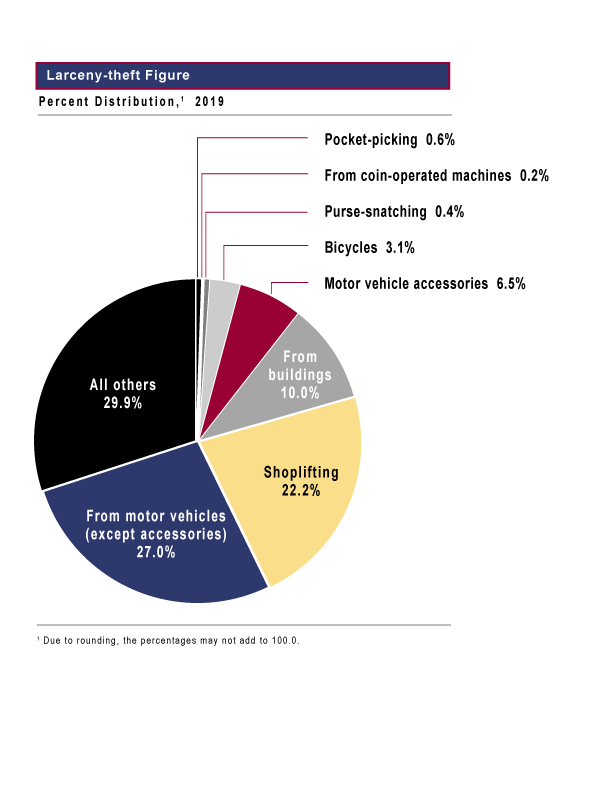Larceny-theft
Definition
The FBI’s Uniform Crime Reporting (UCR) Program defines larceny-theft as the unlawful taking, carrying, leading, or riding away of property from the possession or constructive possession of another. Examples are thefts of bicycles, thefts of motor vehicle parts and accessories, shoplifting, pocket-picking, or the stealing of any property or article that is not taken by force, violence, or fraud. Attempted larcenies are included in offense totals. Embezzlement, confidence games, forgery, check fraud, etc., are excluded.
Overview
- In 2019, there were an estimated 5,086,096 larceny-thefts nationwide. The number of larceny-thefts declined 2.8 percent when compared with the 2018 estimate. The number decreased 11.1 percent when compared with the 2015 estimate, and it declined 18.0 percent when compared with the 2010 estimate. (See Table 1.)
- The rate of estimated larceny-thefts in 2019 was 1,549.5 per 100,000 inhabitants. From 2018 to 2019, the rate of estimated larceny-thefts declined 3.3 percent, and from 2010 to 2019, the rate decreased 22.7 percent. (See Tables 1 and 1A.)
- Larceny-thefts accounted for an estimated 73.4 percent of property crimes in 2019. (Based on Table 1.)
- The average value of property taken during larceny-thefts was $1,162 per offense. When the average value is applied to the estimated number of larceny-thefts, the loss to victims nationally was an estimated $5.9 billion. (Based on Tables 1 and 23.)
- Thefts from motor vehicles accounted for 27.1 percent of all larceny-thefts in 2019. (See Table 23.)
Expanded data
Expanded offense data are the details of the various offenses that the UCR Program collects beyond the count of how many crimes law enforcement agencies report. These details may include the type of weapon used in a crime, type or value of items stolen, and so forth. In addition, expanded data include trends (for example, 2-year comparisons) and rates per 100,000 inhabitants.
Expanded information regarding larceny-theft is available in the following tables:
- Offense Analysis: Table 23
- Larceny-theft Table, “Larceny-theft, Percent Distribution by Region, 2019”
Larceny-theft Figure
This figure is a pie chart that breaks down (by percent distribution) the types of larceny-thefts that occurred in 2019. In the nation, 27.0 percent of larceny-theft offenses were from motor vehicles (except accessories), 22.2 percent were shoplifting, 10.0 percent were from buildings, 6.5 percent were motor vehicle accessories, 3.1 percent were bicycles, 0.6 percent were pocket-picking, 0.4 percent were purse-snatching, and 0.2 percent were from coin-operated machines. All other larceny-thefts accounted for the remaining 29.9 percent.


